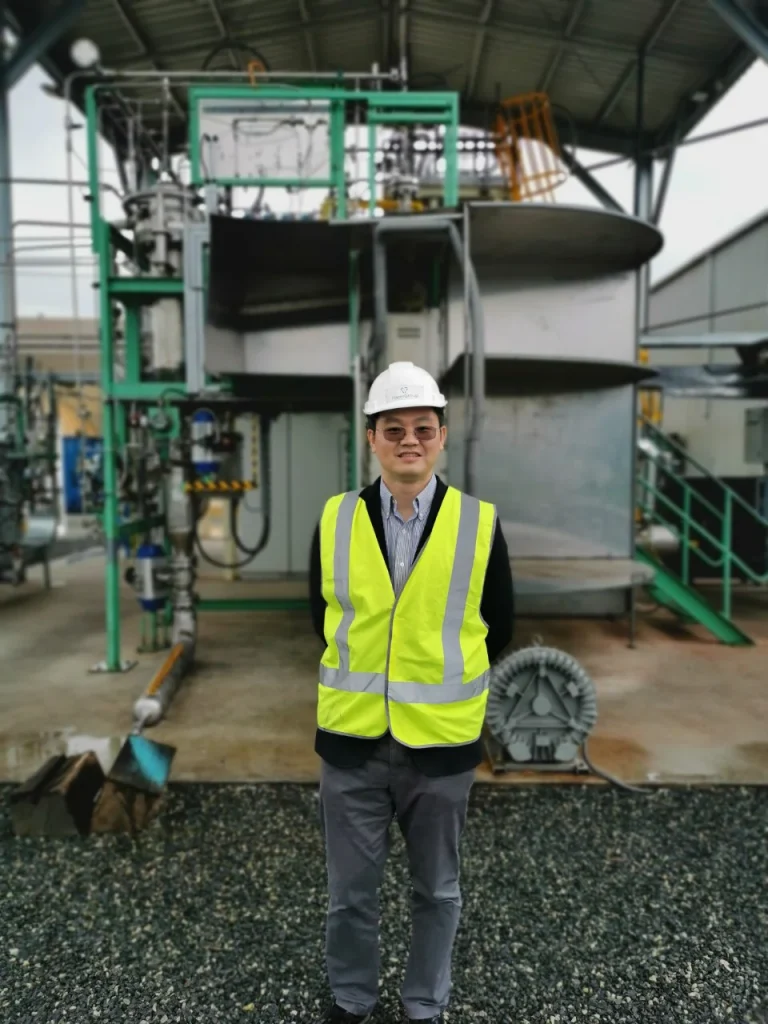Establishing the green edge in a new hydrogen production process
By Michelle Fincke

The global race to make affordable, sustainable hydrogen is so highly competitive, every advantage counts.
That’s why the University of Sydney Net Zero Initiative’s first round of seed funding has zeroed in on a project that will help drive the business case not just for an innovative method of producing hydrogen, but also its valuable new green graphite byproduct.
Australian energy start-up Hazer Group has partnered with the university, each contributing $37,500 towards research into the commercial potential of graphite byproduct from methane pyrolysis: Hazer’s innovative method of making hydrogen that doesn’t release carbon dioxide into the atmosphere.
Instead, the process turns carbon atoms in methane into a graphite product with a range of applications such as batteries, water treatment and thermal energy storage.
According to the University of Sydney’s project lead, Professor Yuan Chen (pictured) from the School of Chemical and Biomolecular Engineering, the emerging Net Zero-emissions energy space is so competitive, green credentials and business cases must be underpinned by rigorous research to generate impact for both balance sheet and environment.
Hazer hopes that harnessing University of Sydney’s multi-disciplinary engineering teams, global networks and experienced academics like Professor Chen – a leading carbon materials researcher – will give them an edge. Identifying the best use for their graphite while also building a balance sheet detailing the process’s CO2 emission reduction, will provide a full picture of its value.
It takes energy to make energy
Hydrogen’s role in a Net Zero future is hotly anticipated by many, but as Professor Chen cautions, it takes energy to make energy. If the hydrogen isn’t efficiently produced, clean and affordable, it won’t solve Earth’s climate problems.
There are a range of processes either in use or development for making hydrogen to achieve Net Zero goals, but Professor Chen says some are still expensive and energy-hungry. They include ‘water-splitting’, a method that uses electricity to harvest hydrogen and oxygen.
Hazer was founded in 2010 to commercialise a promising University of Western Australia research discovery. Using iron ore as a catalyst, the Hazer Process turns methane – the largest component of natural gas – into hydrogen and a solid graphite byproduct.
“This methane pyrolysis process is, I feel, a very good alternative,” Professor Chen says. “Splitting methane requires much less energy inputs than splitting water. Methane is abundant; plus, we also have biogas, which is generated from the waste from plants and, if we could turn that into hydrogen, then the cost actually will be lower than water splitting.”
Staying competitive in a fast changing industry
But in a fast-changing, highly competitive industry, the equations are complex and every advantage counts. Hazer is working in tandem with University of Sydney experts to find the most suitable applications and markets to maximise the graphite’s value, which will offset the cost of its hydrogen production.
“Competing with existing material is always difficult, because the existing material has been refined over decades,” Professor Chen explains. “When you create a new material to replace it, in terms of costs and the quality, it’s always a very difficult competition.
“But the one thing which could win the market over is that this new material is carbon neutral, or even carbon negative, so you bring CO2 out of the atmosphere. If we can establish a clear picture of how much CO2 emission reduction you can achieve by using this new carbon material, that will add value to the customer, and of course also will help to sell the product better.
“The bigger mission is to find an alternative approach to produce hydrogen without CO2 emission while also making the whole process financially or economically feasible. People are trying many creative ideas to produce hydrogen, but if the process is costly and it cannot compete with existing methods, it will be difficult for it to take off.”
Professor Chen and his research collaborators will review relevant literature and work closely with Hazer’s own researchers and business development personnel to inform next steps.
The power of long-term collaboration
While this important research project is new, the partnership between Hazer Group and the University of Sydney’s School of Chemical and Biomolecular Engineering began in 2016.
According to Professor Chen, key to the relationship’s success is each partner’s shared common interest and trust in their different approaches. Hazer gains access to the knowledge, experience and networks forged by academics from the University of Sydney, while students benefit from proximity to dynamic, “real-world” discoveries and the opportunities they offer.
And for researchers who have traditionally focused purely on the academic discovery, Professor Chen says the Hazer partnership expands their horizons, enabling them to work in multidisciplinary teams to focus on issues like scalability, commercial viability and even marketing.
“We want to work on something which will be impactful for our society, not just for academic curiosity and fun,” he laughs. “Fun is good, but this is something which can create an impact, especially at this time. This new process has good potential to complement or even replace the existing method for hydrogen production.
“In Australia, much of the economy is based on selling our minerals, our food products. Now, if we do have a new and cost-effective process to produce hydrogen, that could be our next important export. It could solve the problem of CO2 emissions, but also bring new economic benefits to help sustain our society.”

